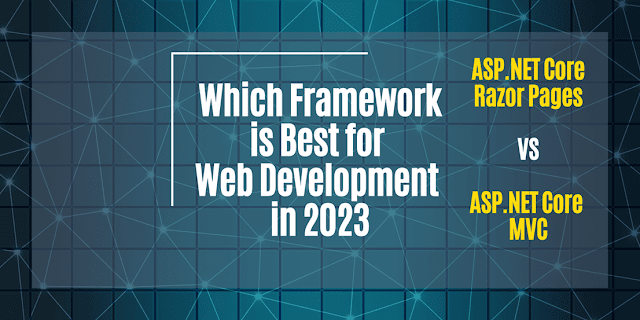ASP.NET Core Razor Pages and ASP.NET Core MVC are both popular frameworks for creating web applications. Both frameworks have their own strengths and weaknesses and the choice between the two ultimately comes down to the specific requirements of the project. In this article, we will compare ASP.NET Core Razor Pages and ASP.NET Core MVC to help you decide which one will create better web applications in 2023.
ASP.NET Core Razor Pages
ASP.NET Core Razor Pages is a newer framework introduced in ASP.NET Core 2.0. It is designed to make it easier to create simple, static websites and web applications. Razor Pages is a page-focused framework that enables developers to create pages for the web with minimum coding. It uses the Razor syntax to generate HTML and supports model binding, which makes it easy to get started with.
Pros:
- Easy to use: Razor Pages are designed to be easy to use and requires less code compared to MVC.
- Simple structure: Razor Pages have a simple structure that makes it easy for developers to understand and maintain the code.
- Easy to test: Testing Razor Pages is easier as it does not have complex routing like MVC.
Cons:
- Limited flexibility: Razor Pages are limited in their flexibility compared to MVC, making it unsuitable for complex web applications.
- Less control over HTML: With Razor Pages, developers have less control over HTML, making it difficult to create custom views.
ASP.NET Core MVC
ASP.NET Core MVC is a well-established framework that has been around since the early days of ASP.NET. It is a model-view-controller (MVC) framework that provides a clear separation of concerns between the model, view, and controller. MVC is a more complex framework compared to Razor Pages, but it provides more control over HTML and allows for a greater degree of customization.
Pros:
- More control over HTML: MVC provides more control over HTML, making it easier to create custom views.
- More flexible: MVC is more flexible compared to Razor Pages, making it suitable for complex web applications.
- Advanced features: MVC provides advanced features such as routing, filters, and action results, making it easier to create more complex web applications.
Cons:
- More complex: MVC is more complex compared to Razor Pages, making it harder for developers to get started with.
- More code: MVC requires more code compared to Razor Pages, making it harder to maintain.
When to Use What: ASP.NET Core Razor Pages vs MVC
Both ASP.NET Core Razor Pages and ASP.NET Core MVC are frameworks for building dynamic web applications using the ASP.NET Core platform, but they have some key differences in terms of the architecture and approach they take to building web applications.
ASP.NET Core Razor Pages are designed for building simple, page-based web applications with a focus on UI and UX, and are a good fit for building applications that follow a traditional request-response model, such as a simple website or a web-based CRUD (Create, Read, Update, Delete) application.
Examples of applications that could be built using ASP.NET Core Razor Pages include:
- A simple personal blog
- A small business website
- A web-based to-do list application
- A CRUD application for managing customer data
On the other hand, ASP.NET Core MVC is a more flexible and powerful framework for building dynamic web applications, and is a good fit for building more complex, scalable applications that require fine-grained control over the request-response cycle and a more modular, testable architecture.
Examples of applications that could be built using ASP.NET Core MVC include:
- A large e-commerce website
- A social networking site
- A web-based project management application
- A real-time data visualization and analysis platform
What Design Patterns can be Implemented with ASP.NET Core Razor Pages and ASP.NET MVC
- Model-View-Controller (MVC) pattern: This is the pattern that ASP.NET Core MVC and Razor Pages are built upon, and it separates the application into three main components: the model (which represents the data), the view (which displays the data), and the controller (which handles user input and updates the model).
- Repository pattern: This pattern provides a separation between the data access layer and the business logic layer, allowing you to encapsulate the data access logic and make it easier to test and maintain your code.
- Dependency Injection pattern: This pattern makes it easy to manage dependencies between components in your application, making it easier to test and maintain your code, and allowing you to build more flexible and scalable applications.
- Service layer pattern: This pattern provides a separation between the data access logic and the business logic, making it easier to test and maintain your code, and allowing you to build more flexible and scalable applications.
- Model-View-ViewModel (MVVM) pattern: This pattern is often used in combination with ASP.NET MVC or Razor Pages and allows you to separate the presentation logic from the business logic, making it easier to maintain and test your code.
Conclusion
In conclusion, both ASP.NET Core Razor Pages and ASP.NET Core MVC have their own strengths and weaknesses. Razor Pages is best for simple, static websites and web applications, while MVC is better for complex web applications. In 2023, the choice between the two frameworks ultimately comes down to the specific requirements of the project and your personal preferences as a developer. Both frameworks have a large and active community of developers and support a wide range of tools and technologies, so it is possible to build a wide range of applications using either framework.

